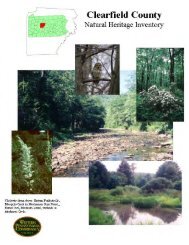Rice Cutgrass – Bulrush Vernal Pool System - Pennsylvania Natural ...
Rice Cutgrass – Bulrush Vernal Pool System - Pennsylvania Natural ...
Rice Cutgrass – Bulrush Vernal Pool System - Pennsylvania Natural ...
You also want an ePaper? Increase the reach of your titles
YUMPU automatically turns print PDFs into web optimized ePapers that Google loves.
material, loss of vegetation eliminates egg-laying sites. For species that lay their eggs in the water,<br />
removal of vegetation reduces shade.<br />
Roads near vernal pools present a physical obstacle to animals moving from their upland feeding<br />
habitats to their vernal pool breeding habitats. Many animals are killed as they attempt these crossings.<br />
The presence of roads also provides opportunities for undesirable elements to get into the pools. Roads<br />
bring invasive plant species, sediments, and contaminants to pools through runoff. During the winter<br />
the application of road salt poses a problem for pools located near roads. As the snow melts, salt-laden<br />
water flows into these pools and increases the salinity of the water, making the water less hospitable to<br />
wildlife.<br />
All aspects of life in a vernal pool, from amphibian migration to egg and larval development to adult<br />
feeding, thermoregulation, and reproductive success, depend on certain environmental cues and<br />
conditions. Climate change is of increasing concern for species of special concern, especially in regard to<br />
species that are geographically restricted.<br />
Management<br />
A natural buffer around the wetland should be maintained in order to minimize nutrient runoff,<br />
pollution, and sedimentation. Protecting vernal pools and the surrounding 1000 feet of upland habitat is<br />
critical for protection of water quality, amphibian breeding, and terrestrial habitat for adult and juvenile<br />
amphibians. Soil erodibility in terms of the soil texture, condition of the adjacent vegetation (mature<br />
forests vs. clearcuts) and the topography of the surrounding area (i.e. degree of slope) should be<br />
considered when establishing buffers. Impervious surfaces surrounding the wetland should be<br />
minimized to prevent thermal pollution. Direct impacts and habitat alteration should be avoided (i.e.<br />
roads, trails, filling of wetland) and low impact alternatives (i.e. elevated footpaths, boardwalks, bridges)<br />
should be utilized in situations where accessing the wetland can not be avoided. Care should also be<br />
taken to control and prevent the spread of invasive species within the wetland.<br />
Research Needs<br />
There is a need to collect community plot data to characterize variations of this community to assist<br />
further classification of this community.<br />
Trends<br />
These wetlands were probably more common but declined due to wetland draining/filling and clearing<br />
of the adjacent lands leading to increased evaporation of the standing water and sedimentation.<br />
Range Map










